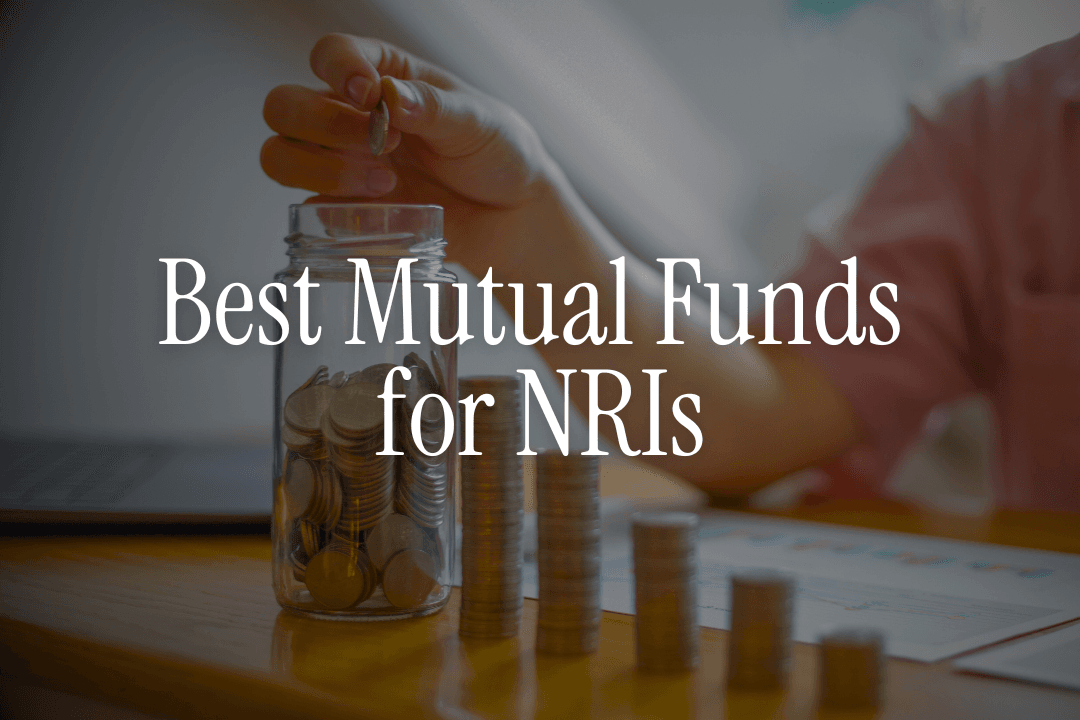
"I know mutual funds can potentially beat FD returns, but as an NRI living in Dubai, can I even invest in them legally? And if yes, which ones won't land me in tax trouble?"
If you're like most NRIs I talk to, you've probably heard your colleagues mention 15-20% returns from Indian mutual funds while your UAE bank account earns 0.1%.
You've seen WhatsApp forwards about "best performing funds," but every time you try to research, you hit a wall of confusing tax rules, FATCA compliance requirements, and conflicting advice.
I get it. After 12 years of helping NRIs navigate Indian investments, I've seen smart professionals who can manage million-dirham portfolios get completely stumped by India's mutual fund regulations.
Here's what this guide will clear up: whether you can legally invest, which specific funds make sense for your situation, how the tax actually works in your country, and most importantly — how to start investing next week without getting trapped in compliance issues.
By the end, you'll know exactly which platform to use, which fund categories to focus on, and how to avoid the seven most common mistakes that cost NRIs thousands every year.
Quick Answer: Yes, You Can Invest (But There Are Rules)
The Bottom Line:
- Legal Status: NRIs can invest in Indian mutual funds under FEMA regulations
- Best Categories: Large-cap and flexi-cap funds for beginners, index funds for simplicity
- Tax Reality: Same tax rates as residents, but DTAA can help reduce double taxation
- Platform Winners: HDFC, ICICI, and Axis for UAE NRIs; limited options for US/Canada
- Minimum Investment: ₹500-₹1000 monthly SIP for most funds
Quick Recommendations by Country:
- UAE/GCC: Focus on equity funds via NRE accounts, claim DTAA benefits
- US NRIs: Limited to specific AMCs due to FATCA; consider Nippon, UTI, Aditya Birla
- Canada NRIs: Similar restrictions as US; some AMCs accept offline investments
- Other Countries: Full access to all mutual fund categories
Red Flags to Avoid:
- Any scheme promising guaranteed 20%+ returns
- Platforms asking for investments in foreign currency
- Funds requiring upfront commissions or fees
What Mutual Funds Actually Mean for NRIs
Think of mutual funds as hiring a professional money manager to invest your money across hundreds of Indian companies. Instead of picking individual stocks (which requires serious research), you pool your money with thousands of other investors.
Here's why this matters for NRIs specifically:
Currency Advantage: When you invest through your NRE account, you're essentially betting on both the fund's performance AND the rupee's movement. If Indian markets perform well AND the rupee strengthens, you get double benefits.
Professional Management: Indian fund managers have local insights you can't get sitting in Dubai or New York. They understand regulatory changes, monsoon impacts on agriculture stocks, and government policy shifts.
Diversification: A single mutual fund investment gives you exposure to 50-100 companies across sectors. Much easier than researching individual stocks from abroad.
Types of Mutual Funds Available to NRIs
Equity Funds (Stock-based):
- Large-cap: Top 100 companies (safer, steady growth)
- Mid-cap: Companies ranked 101-250 (higher growth potential, more volatile)
- Small-cap: Smaller companies (highest risk and reward)
- Flexi-cap: Mix of all company sizes (balanced approach)
Debt Funds (Bond-based):
- Corporate bonds, government securities
- Lower risk than equity, better than bank FDs
- Good for conservative investors
Hybrid Funds:
- Mix of stocks and bonds
- Balanced risk-reward profile
ELSS (Tax-saving funds):
- 3-year lock-in period
- Tax deduction under Section 80C
- Good for NRIs with Indian tax obligations
👉 Tip: Start with large-cap or flexi-cap funds if you're new to mutual fund investing. They offer the best balance of growth potential and stability.
Legal Framework: What FEMA Actually Says
The Foreign Exchange Management Act (FEMA) 1999 explicitly allows NRIs to invest in Indian mutual funds. Here's what you need to know:
Who Qualifies as NRI
You're an NRI if you've been outside India for more than 182 days in a financial year. This definition affects your tax treatment, not your investment eligibility.
Important: Even if you become a resident again, your existing mutual fund investments continue normally.
Investment Accounts Required
You must invest through:
- NRE Account: For repatriable investments (can bring money back abroad)
- NRO Account: For non-repatriable investments (limited repatriation of ₹1 million annually)
You cannot invest through:
- Regular resident savings accounts
- Foreign currency accounts (mutual funds only accept INR)
What's Not Allowed
- Direct foreign currency investments in mutual funds
- Investments through joint accounts with residents
- Using someone else's account (even family members)
Tax Implications: The Real Story by Country
This is where most articles get confusing. Let me break it down by your residence country:
For UAE/GCC Residents
In India:
- Short-term gains (under 1 year): 20% tax
- Long-term gains (over 1 year): 12.5% on gains above ₹1.25 lakh
- No TDS on NRE account investments
In UAE:
- No income tax on mutual fund gains (UAE doesn't tax investment income)
- Result: You only pay Indian taxes, making this very tax-efficient
For US NRIs
In India:
- Same tax rates as above
- Can claim DTAA benefits to reduce rates
In USA:
- Indian mutual funds treated as "Passive Foreign Investment Companies" (PFICs)
- Complex tax reporting required (Form 8621)
- May face higher tax rates than domestic US investments
- Warning: This makes Indian mutual funds less attractive for US tax residents
For Canada NRIs
In India:
- Standard tax rates apply
- DTAA benefits available
In Canada:
- Foreign accrual property income rules may apply
- Need to report on T1135 form
- Can claim foreign tax credits for Indian taxes paid
For UK/Other Countries
Most other countries allow you to claim foreign tax credits for taxes paid in India, making mutual fund investments more tax-efficient.
Key Point: Always consult a tax advisor in your resident country before investing large amounts.
👉 Tip: Keep detailed records of all mutual fund transactions and tax payments in India. You'll need these for claiming DTAA benefits in most countries.
Platform Experience: Which AMCs Actually Work for NRIs
I've personally tested the application process across major platforms. Here's what actually works:
Excellent for Gulf NRIs
HDFC Mutual Fund:
- Digital Experience: Smooth online application, usually approved in 5-7 days
- NRI Support: Dedicated helpline with UAE timing
- Fund Options: Full range including top-performing large-cap and flexi-cap funds
- Fees: Competitive expense ratios (1-2.5% annually)
ICICI Prudential:
- Digital Experience: Clean interface, good mobile app
- Documentation: Accepts digital signatures and uploads
- Special Feature: Allows SIP modifications online
- Customer Service: Responsive to Gulf NRI queries
Axis Mutual Fund:
- Digital Experience: Recently improved online platform
- NRI Features: Dedicated NRI portal with country-specific guidance
- Processing Time: 3-5 days for account approval
Limited Options for US/Canada NRIs
Due to FATCA compliance requirements, only select AMCs accept US and Canadian NRIs:
Online Access:
- Nippon India Mutual Fund
- UTI Mutual Fund
- Aditya Birla Sun Life
- HDFC (select schemes only)
Offline Only:
- SBI Mutual Fund (requires physical presence)
- DSP Mutual Fund
- Franklin Templeton
What Doesn't Work Well
Groww/Zerodha Coin: These popular platforms often restrict NRI registrations or have poor customer support for overseas residents.
Direct AMC websites: Many crash during peak hours or have poor mobile optimization.
Best Fund Categories for NRIs (With Real Performance Data)
Based on 5-year performance and consistency, here are the categories that work best for NRIs:
Large-Cap Funds (Safest Entry Point)
Why They Work for NRIs:
- Lower volatility during market crashes
- Easier to understand and track
- Good liquidity for when you need to exit
Top Performers (5-year returns):
- ICICI Pru Bluechip Fund: ~12-15% CAGR
- Aditya Birla Sun Life Large Cap: ~11-14% CAGR
- Axis Bluechip Fund: ~10-13% CAGR
Best For: Conservative NRIs, first-time mutual fund investors, those planning to invest for 3-5 years.
Flexi-Cap Funds (Balanced Growth)
Why NRIs Love Them:
- Fund manager can adjust between large, mid, and small companies based on market conditions
- Higher growth potential than pure large-cap funds
- Good for long-term wealth creation
Top Performers:
- Parag Parikh Flexi Cap: ~14-17% CAGR
- PGIM India Flexi Cap: ~13-16% CAGR
- Quant Flexi Cap: ~15-18% CAGR (higher risk)
Best For: NRIs with 5-10 year investment horizon, those comfortable with moderate volatility.
Index Funds (Set-and-Forget Option)
Why They Make Sense:
- Low fees (0.1-0.5% annually vs 1-2.5% for actively managed funds)
- No fund manager risk
- Easy to understand and track
Best Options:
- Nifty 50 Index Funds (tracks top 50 companies)
- Nifty Next 50 (tracks companies ranked 51-100)
- Nifty 500 (broader market exposure)
Best For: NRIs who want market returns without active management, cost-conscious investors.
ELSS Funds (Tax-Saving Option)
Benefits for NRIs:
- Section 80C deduction (up to ₹1.5 lakh annually)
- Only 3-year lock-in (shortest among tax-saving options)
- Potential for higher returns than traditional tax-saving instruments
Top Performers:
- Axis Long Term Equity Fund
- Mirae Asset Tax Saver Fund
- DSP Tax Saver Fund
Best For: NRIs with significant Indian income or those planning to return to India.
Currency Risk: The Factor Most NRIs Ignore
When you invest in Indian mutual funds through your NRE account, you're taking two risks:
- Fund Performance Risk: Will the fund generate good returns?
- Currency Risk: Will the rupee strengthen or weaken against your home currency?
How Currency Risk Affects Your Returns
Example: You invest $10,000 when USD/INR is 83. You get ₹8.3 lakh to invest.
Scenario 1 (Rupee Weakens):
- Your fund grows 15% to ₹9.54 lakh
- USD/INR moves to 85
- Your dollar value: $11,223 (12.2% return)
Scenario 2 (Rupee Strengthens):
- Your fund grows 15% to ₹9.54 lakh
- USD/INR moves to 80
- Your dollar value: $11,925 (19.2% return)
Historical Currency Impact
Over the past 5 years, INR has generally weakened against major currencies:
- USD: ~13% depreciation
- AED: ~13% depreciation (pegged to USD)
- GBP: ~8% depreciation
This means even funds generating 12-15% returns may have delivered lower returns in foreign currency terms.
Hedging Strategies for NRIs
Diversification Approach:
- 50% in Indian mutual funds (INR exposure)
- 30% in international funds or USD investments
- 20% in your home country investments
Timing Strategy:
- Invest when rupee is weak (better entry point)
- Consider partial withdrawals when rupee strengthens significantly
👉 Tip: Don't let currency risk stop you from investing, but be aware of it. Over 10+ years, good Indian companies tend to outperform currency fluctuations.
FATCA Compliance: What US and Canada NRIs Must Know
If you're a US or Canadian tax resident, investing in Indian mutual funds involves additional compliance requirements.
What FATCA Requires
For US NRIs:
- Self-declaration of US tax residency status
- Providing US Tax Identification Number (TIN)
- Annual reporting to IRS on Form 8938 (if total foreign assets exceed $50,000)
Additional US Tax Implications:
- Indian mutual funds treated as PFICs
- Potentially higher tax rates than domestic investments
- Complex annual reporting requirements
Which AMCs Accept US/Canada NRIs (September 2025)
Online Access Available:
- Nippon India Mutual Fund
- UTI Mutual Fund
- Aditya Birla Sun Life Mutual Fund
- Bajaj Finserv Mutual Fund (US only)
- Bandhan Mutual Fund (US only)
Offline/Physical Presence Required:
- SBI Mutual Fund
- DSP Mutual Fund
- Franklin Templeton
Complete Restrictions:
- ICICI Prudential (most schemes)
- HDFC Mutual Fund (most schemes)
- Axis Mutual Fund
Practical Steps for US/Canada NRIs
- Choose Compliant AMCs: Stick to the approved list above
- Complete FATCA Declaration: Provide all required documentation upfront
- Maintain Records: Keep detailed transaction records for US/Canada tax filing
- Consider Alternatives: GIFT City investments or US-based India funds might be simpler
Warning: FATCA compliance rules change frequently. What worked in 2024 may not work in 2025. Always verify current AMC policies before investing.
Step-by-Step Investment Process from Start to Finish
Here's exactly how to start investing, tested from Dubai:
Phase 1: Account Setup (1-2 weeks)
Step 1: Open NRE/NRO Account
- Choose HDFC, ICICI, or Axis Bank (best NRI services)
- Complete online application with NRI documents
- Fund account via wire transfer from your overseas account
Step 2: Complete KYC for Mutual Funds
- Submit: PAN card, passport, visa/Emirates ID, overseas address proof
- In-person verification: Video call or Power of Attorney in India
- FATCA declaration (if applicable)
Phase 2: Platform Selection and Fund Research (3-5 days)
Step 3: Choose Investment Platform
- Direct AMC website (lowest fees) vs. broker platform (convenience)
- For beginners: Start with AMC direct platforms
- For convenience: Use HDFC or ICICI investment portals
Step 4: Fund Selection
- Start with 1-2 funds maximum
- Recommended first investment: Large-cap or flexi-cap fund
- Check fund fact sheet, expense ratio, and 5-year performance
Phase 3: Investment Execution (1 day)
Step 5: Make Your First Investment
- Start with SIP (₹5,000-₹10,000 monthly) rather than lumpsum
- Set up auto-debit from your NRE/NRO account
- Keep initial investment small to test the process
Phase 4: Monitoring and Management (Ongoing)
Step 6: Track Performance
- Check fund performance quarterly (not daily)
- Compare against benchmark index
- Review and rebalance annually
Required Documentation Checklist
Essential Documents:
- ✅ PAN Card (mandatory)
- ✅ Passport with valid visa
- ✅ Overseas address proof (utility bill, bank statement)
- ✅ Recent passport-size photograph
- ✅ Cancelled cheque from NRE/NRO account
Additional for US/Canada NRIs:
- ✅ FATCA self-declaration form
- ✅ US/Canada Tax Identification Number
- ✅ Proof of tax residency
Repatriation Rules: Getting Your Money Back
Understanding how to bring money back abroad is crucial for NRIs.
NRE Account Investments (Fully Repatriable)
No Restrictions:
- Principal and gains are fully repatriable
- No approvals required from RBI
- Transfer at prevailing exchange rates
Process:
- Redeem mutual fund units
- Money credited to NRE account
- Transfer abroad via wire transfer or remittance services
NRO Account Investments (Limited Repatriation)
Annual Limits:
- Up to USD 1 million per financial year
- Includes all NRO account transfers (not just mutual funds)
- Requires CA certification for amounts above $25,000
Tax Implications:
- TDS applies on repatriation
- Can claim DTAA benefits
Practical Tips for Repatriation
Timing Matters:
- Monitor exchange rates before redeeming large amounts
- Consider partial redemptions spread over multiple years
Documentation:
- Keep all investment proof and tax payment receipts
- Required for DTAA claims in your resident country
👉 Tip: If you're unsure about future repatriation needs, start with NRE account investments for maximum flexibility.
Common Mistakes That Cost NRIs Thousands
After reviewing hundreds of NRI portfolios, here are the most expensive mistakes I see:
Mistake 1: Chasing Last Year's Winners
What Happens: Investing in funds that performed well in the previous year
Why It's Costly: Top performers often underperform in subsequent years
Better Approach: Focus on 3-5 year consistent performers
Mistake 2: Over-Diversification
What Happens: Investing in 8-10 different funds across categories
Why It's Costly: Overlapping holdings, high management fees, difficult to track
Better Approach: 2-3 funds maximum for portfolios under ₹10 lakh
Mistake 3: Ignoring Expense Ratios
What Happens: Not checking annual fees before investing
Impact: 2.5% expense ratio vs 0.5% index fund = ₹20,000 annual difference on ₹10 lakh investment
Better Approach: Compare expense ratios alongside performance
Mistake 4: Wrong Account Type Selection
What Happens: Using NRO account when NRE was better (or vice versa)
Why It's Costly: Tax implications and repatriation restrictions
Better Approach: Understand your repatriation needs before choosing account type
Mistake 5: Panic Selling During Market Crashes
What Happens: Selling funds during 20-30% market corrections
Why It's Costly: Locks in losses and misses recovery
Better Approach: Continue SIPs during market downturns for better average pricing
Mistake 6: FATCA Non-Compliance (US/Canada NRIs)
What Happens: Investing through non-compliant platforms
Why It's Costly: Account freezes, penalty charges, tax complications
Better Approach: Verify FATCA compliance before investing
Mutual Funds vs Other NRI Investment Options
Here's how mutual funds stack up against other popular NRI investments:
Factor | Mutual Funds | NRE Fixed Deposits | GIFT City USD FDs | Real Estate |
|---|---|---|---|---|
Expected Returns | 12-15% annually | 6-7% annually | 4-5% annually | 8-12% annually |
Liquidity | High (redeem anytime) | Low (penalty for early exit) | High | Very Low |
Minimum Investment | ₹500 (SIP) | ₹25,000 | $1,000 | ₹25+ lakh |
Tax Efficiency | LTCG 12.5% | Tax-free (NRE) | Tax-free | High (various exemptions) |
Currency Risk | High | High | None | High |
Management Required | Low | None | None | High |
When to Choose Mutual Funds
Best For:
- Long-term wealth creation (5+ years)
- Regular monthly investments (SIPs)
- Higher risk tolerance
- Want professional money management
Avoid If:
- Need guaranteed returns
- Investment horizon under 3 years
- Cannot tolerate 20-30% temporary losses
- US/Canada tax residents (due to PFIC complications)
Emerging Trends: GIFT City and Future Options
GIFT City Mutual Funds
A new development allows certain mutual funds to operate from GIFT City, offering:
Benefits:
- USD-denominated mutual fund investments
- No currency risk for foreign investors
- Tax advantages similar to GIFT City deposits
Current Status:
- Limited fund options available
- Higher minimum investments
- Still evolving regulatory framework
Technology Improvements
Mobile Apps:
- Better NRI-specific features
- International payment gateway integration
- Video KYC from overseas
Digital Documentation:
- Reduced paperwork requirements
- Faster approval processes
- Better customer support
Regulatory Changes (Budget 2025 Impact)
Tax Rate Changes:
- STCG tax increased to 20% from 15%
- LTCG threshold reduced to ₹1.25 lakh
- Impact: Slightly lower post-tax returns, but still attractive for long-term investors
Exit Strategies: When and How to Sell
Market-Based Exit Indicators
Consider Partial Exits When:
- Fund significantly outperforms benchmark for 2+ years
- Market valuations appear extremely high (P/E ratios above historical averages)
- You've achieved specific financial goals
Avoid Exits During:
- Short-term market volatility (10-20% corrections)
- Economic uncertainty phases
- First 3 years of investment (give funds time to perform)
Personal Situation-Based Exits
Full Exit Scenarios:
- Returning to India permanently (may switch to resident options)
- Major life changes requiring large funds
- Significant change in risk tolerance
Partial Exit Scenarios:
- Rebalancing portfolio annually
- Taking profits after exceptional years
- Meeting specific financial goals (children's education, home purchase)
Tax-Efficient Exit Strategies
For Long-term Gains:
- Plan exits to stay within ₹1.25 lakh annual LTCG exemption
- Spread large redemptions across multiple years
- Consider switching between funds within same AMC (no tax impact)
For Short-term Holdings:
- Avoid exits before 1-year completion if possible
- If needed, offset with losses from other investments
Exit Process
- Review Performance: Compare fund vs benchmark over 3+ years
- Tax Planning: Calculate tax implications of redemption
- Market Timing: Avoid panic exits during market lows
- Gradual Exit: Consider systematic withdrawal plans for large amounts
- Repatriation: Plan currency exchange timing for optimal rates
👉 Tip: Set specific exit criteria when you start investing. This helps avoid emotional decisions during market volatility.
Estate Planning Considerations for NRIs
Nomination and Succession
Why It Matters:
- Avoids legal complications for family
- Faster claim settlement
- Reduces documentation requirements
Process:
- Add nominee during account opening
- Can be changed anytime online
- Nominee can be resident or non-resident
Cross-Border Estate Planning
Key Considerations:
- Will validity in multiple countries
- Tax implications for heirs
- Power of attorney arrangements
Best Practices:
- Maintain updated will in both India and resident country
- Consider professional estate planning advice
- Keep investment records accessible to family
Conclusion: Your Next Steps Mapped Out
Here's what you now know about mutual fund investing as an NRI:
Legal Framework: You can legally invest under FEMA, but need proper NRE/NRO accounts and KYC compliance.
Tax Reality: Same rates as residents, but DTAA benefits can help reduce double taxation. US/Canada NRIs face additional FATCA complexities.
Best Categories: Large-cap and flexi-cap funds offer the best balance of growth and stability for most NRIs.
Platform Choice: HDFC, ICICI, and Axis work well for Gulf NRIs. US/Canada NRIs have limited but viable options.
Currency Risk: Real but manageable over long time periods. Don't let it stop you from investing in high-growth opportunities.
Repatriation: NRE investments are fully repatriable; NRO has annual limits but still workable.
Your Action Plan for the Next 30 Days
Week 1: Open NRE/NRO account with HDFC, ICICI, or Axis Bank.
Week 2: Complete mutual fund KYC and choose 1-2 funds from our recommended categories.
Week 3: Start with small SIP (₹5,000-₹10,000 monthly) to test the process.
Week 4: Set up monitoring system and plan for annual reviews.
For Detailed Guidance:
- Compare best NRI account options for your specific country
- Understand NRI taxation rules for your investments
- Explore GIFT City investment options for currency protection
- Learn about DTAA benefits for your country
Ready to Start? Download Belong App and join our NRI Investment WhatsApp Community where over 8,000 Gulf-based NRIs share experiences and get expert guidance on mutual fund investing.
Disclaimer: Mutual fund investments are subject to market risks. Read all scheme-related documents carefully. Past performance doesn't guarantee future results. This article is for educational purposes and shouldn't be considered personalized investment advice. Always consult with a SEBI-registered advisor for your specific situation.




